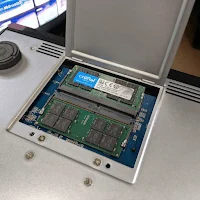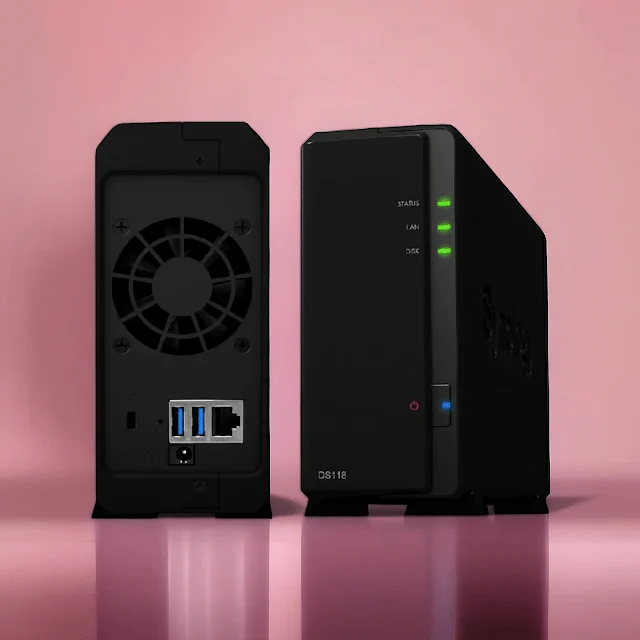
📊 Specifications of Synology DS1621+
Detailed Specifications:
- Processor: AMD Ryzen V1500B Quad-Core 2.2 GHz
- Memory: 4GB DDR4 ECC RAM (expandable up to 32GB)
- Drive Bays: 6 bays (supports 3.5″ SATA HDD, 2.5″ SATA SSD)
- Maximum Storage Capacity: Up to 108TB (with 18TB drives, expandable via DX517)
- RAID Support: RAID 0, 1, 5, 6, 10, and Synology Hybrid RAID (SHR)
- NVMe SSD Cache: 2 x M.2 2280 NVMe slots
- Network Ports: 4 x 1GbE LAN (Link Aggregation & Failover support)
- USB Ports: 3 x USB 3.2 Gen 1
- eSATA Ports: 2 x eSATA for expansion
- File System: Btrfs, EXT4
- Operating System: Synology DiskStation Manager (DSM)
- Dimensions: 282 x 243 x 166 mm
- Weight: 5.1 kg
- Power Consumption: 51.05W (access), 25.27W (HDD hibernation)
- Cooling System: Dual 92mm fans
- Warranty: 3 years (extendable to 5 years)
✅ Can Synology DS1621+ Handle Website Hosting?
Yes, the DS1621+ can function as a self-hosted web server, provided that it is configured correctly and optimized for performance. With its powerful AMD Ryzen V1500B quad-core processor and support for up to 32GB of RAM, it can handle moderate to high web traffic. However, there are key factors that influence its efficiency as a hosting server:
⚡ Performance & Load Capacity
A website’s performance depends on several elements, including CPU power, storage type, and network speed. The DS1621+ is capable of handling up to 50,000 daily visitors for a well-optimized website, assuming proper caching and load balancing. However, this depends on the type of website:
- Static Websites (e.g., blogs, company websites): Can handle 100,000+ visitors/day with caching.
- Dynamic Websites (e.g., WordPress, eCommerce): Ideal for 30,000 – 50,000 visitors/day with proper optimization.
- Large Applications (e.g., forums, web apps): Performance depends on RAM and CPU usage but can handle 10,000 – 20,000 users/day efficiently.
🔄 HDD vs. SSD: Which One to Use?
Your choice of storage significantly impacts loading speeds and responsiveness:
HDD (Hard Disk Drive) 🛑
- Slower read/write speeds (~150 MB/s).
- Suitable for file storage, backups, and low-traffic websites.
- Risk of mechanical failure over time.
SSD (Solid State Drive) ✅
- Faster read/write speeds (~500 MB/s or more with NVMe cache).
- Essential for high-performance web hosting.
- Reduces page loading times and improves SEO rankings.
🔹 Recommended Setup:
- Use 2x 1TB NVMe SSDs for caching to boost speed.
- Store website files on Enterprise-grade SATA SSDs (e.g., Samsung 870 EVO or Seagate IronWolf SSD).
- For backups and archiving, use HDDs.
🔄 SSD Cache for Faster Performance

Caching is essential for speeding up website performance and reducing server load.
Why Use SSD Cache? ✅
- Reduces load times: Speeds up database queries and file retrieval.
- Improves response time: Faster access for dynamic content like WordPress.
- Extends HDD lifespan: Fewer read/write operations on traditional hard drives.
Recommended Setup:
- NVMe SSDs for cache (e.g., Samsung 970 EVO Plus, WD Black SN850).
- Enterprise-grade SATA SSDs for storage (e.g., Samsung 870 EVO, Seagate IronWolf SSD).
- HDDs for backup storage and archiving.
🛠️ Heat Management & Uptime
 🔥 Does the DS1621+ Overheat?
🔥 Does the DS1621+ Overheat?
- The default cooling system keeps temperatures stable under normal workloads.
- Heavy loads may cause heating, so consider external cooling solutions like extra fans or placing it in a ventilated area.
🔋 Backup Power Supply (UPS)
- Power outages can cause data corruption and downtime.
- Invest in a UPS (Uninterruptible Power Supply) like APC Smart-UPS 1500VA to keep your server running for 2-3 hours.
- For extended outages, a battery backup system can power your NAS for 1-2 days.
📁 Using Synology NAS as Your Private Google Drive & Google Photos Alternative
With Synology’s suite of applications, you can replace Google Drive and Google Photos while maintaining complete control over your data.
How It Works:
- Install Synology Drive & Synology Photos apps on your phone and PC.
- Enable auto-upload: Your photos and files sync automatically.
- Secure access: Data is encrypted and stored in your personal cloud.
- Remote Access: View and manage files anywhere with QuickConnect or a VPN.
🔹 Advantage: Unlike Google, there are no monthly fees, and your data stays private!
🌐 Internet Connection & Networking

📶 Internet Speed Requirements
- Minimum upload speed of 50 Mbps for smooth performance.
- For high-traffic sites, a gigabit fiber connection (1000 Mbps) is ideal.
🔄 Should You Use Multiple Internet Connections?
If your website relies on 24/7 uptime, having two separate internet connections with a failover router (like the Ubiquiti EdgeRouter) can help ensure zero downtime in case of an outage.
🔹 Example Scenario:
- Main Internet: Fiber-optic (1 Gbps) from ISP A.
- Backup Internet: 4G/5G mobile network or DSL from ISP B.
- Failover Router: Ubiquiti EdgeRouter detects an outage and switches traffic to the backup within seconds.
🔥 Best Use Cases for Dual Connections:
✅ Web Hosting & Servers – Prevents downtime for your hosted websites.
✅ Online Businesses – Ensures payment systems and services remain active.
✅ Remote Work & Streaming – No interruptions in Zoom meetings or live streams.
📹 Connecting Security Cameras to Synology DS1621+
The DS1621+ can act as a smart security hub, storing footage from IP cameras with AI-powered recording settings.
Key Features:
- Customizable Retention Period: Store recordings for a set duration (e.g., 30 days, 1 year, etc.).
- Motion-Activated Recording: Save space by recording only when movement is detected.
- 24/7 Continuous Recording: Ideal for high-security environments.
🔹 Example: If you set your cameras to record for one month, the NAS will automatically delete the oldest footage to make room for new recordings. With larger storage, you can extend retention up to a year or more
🔒 Security Measures & User Management
✅ Firewall Protection
- Use Synology Firewall & Security Advisor to block unauthorized access.
- Enable HTTPS & SSL certificates for encrypted communication.
👥 User Access Control
- The DS1621+ allows you to create multiple user accounts with different roles.
- Useful if you have developers, admins, and content creators managing the website.
📂 Daily Backups & Snapshots
- Use Synology Hyper Backup to create automatic daily backups to a secondary NAS or cloud storage.
- For WordPress users, consider plugins like UpdraftPlus for additional security.
🎬 Streaming Movies & TV Shows with Plex or Emby
You can turn the DS1621+ into a personal Netflix using Plex or Emby for media streaming.
Setup Guide:
- Install Plex or Emby on Synology NAS.
- Create an account and link your NAS.
- Upload movies & TV shows to a dedicated folder.
- Access content from any device: Smart TVs, smartphones, or PCs.
🔹 Example: Store your favorite movies on your NAS and stream them on any device just like Netflix, without any monthly fees.
🤔 Should You Use Synology DS1621+ as a Hosting Server?
✅ Pros:
✔️ Full control over server resources.
✔️ No monthly hosting fees.
✔️ Scalability (can expand storage easily).
✔️ Strong security features to protect data.
❌ Cons:
❌ Requires manual maintenance & troubleshooting.
❌ Needs proper cooling & power backup.
❌ Higher initial cost compared to shared hosting plans.
🏆 Final Recommendation
If you have technical knowledge and want full control over your hosting environment, the Synology DS1621+ is a solid choice. However, for absolute beginners, a managed VPS or dedicated server might be a more convenient option.
💡 Wise Advice:
“A self-hosted website is a long-term investment. While it gives you full control, you must ensure proper security, power backup, and network redundancy. Plan ahead and treat your NAS like a professional server.” ✅








